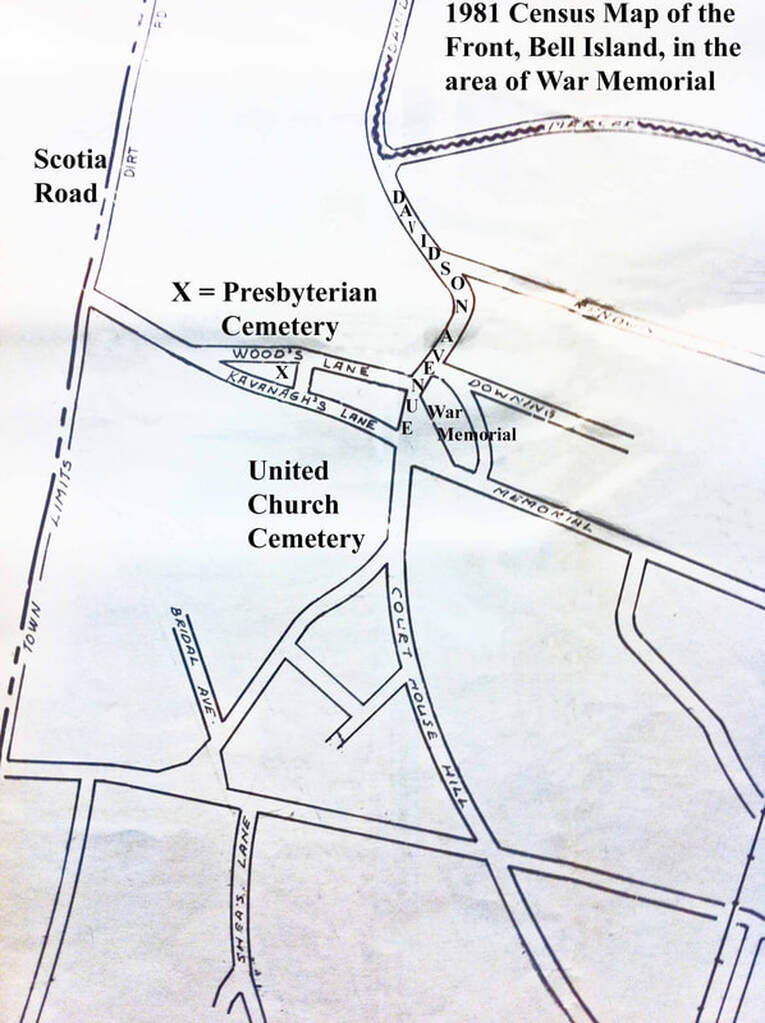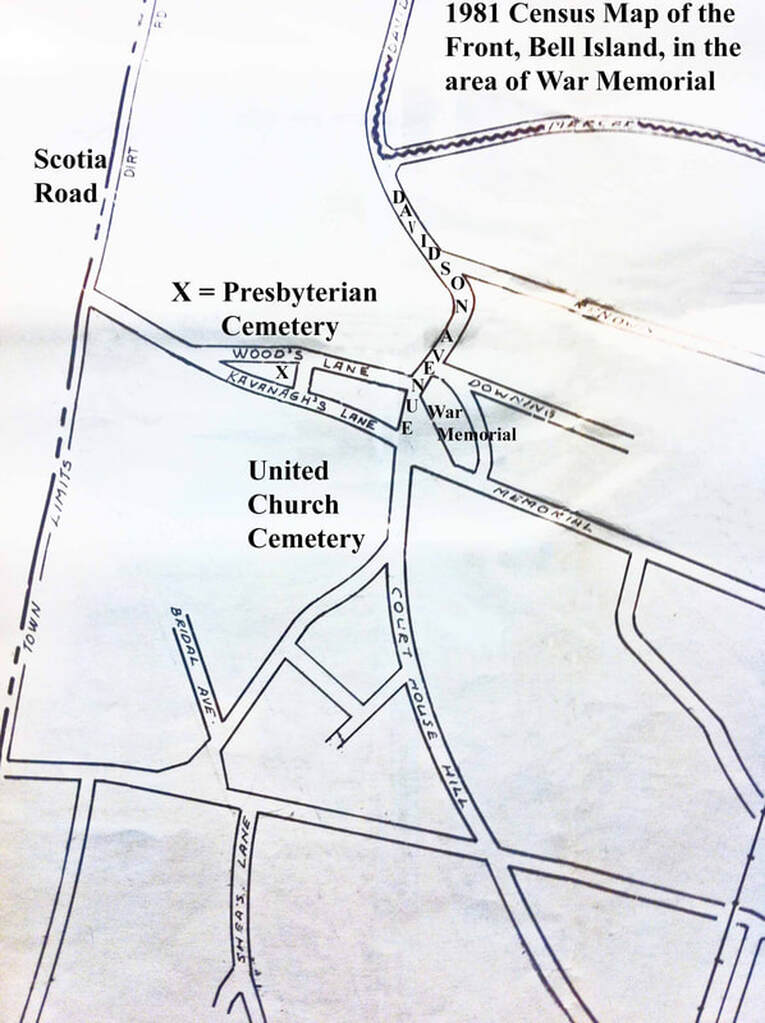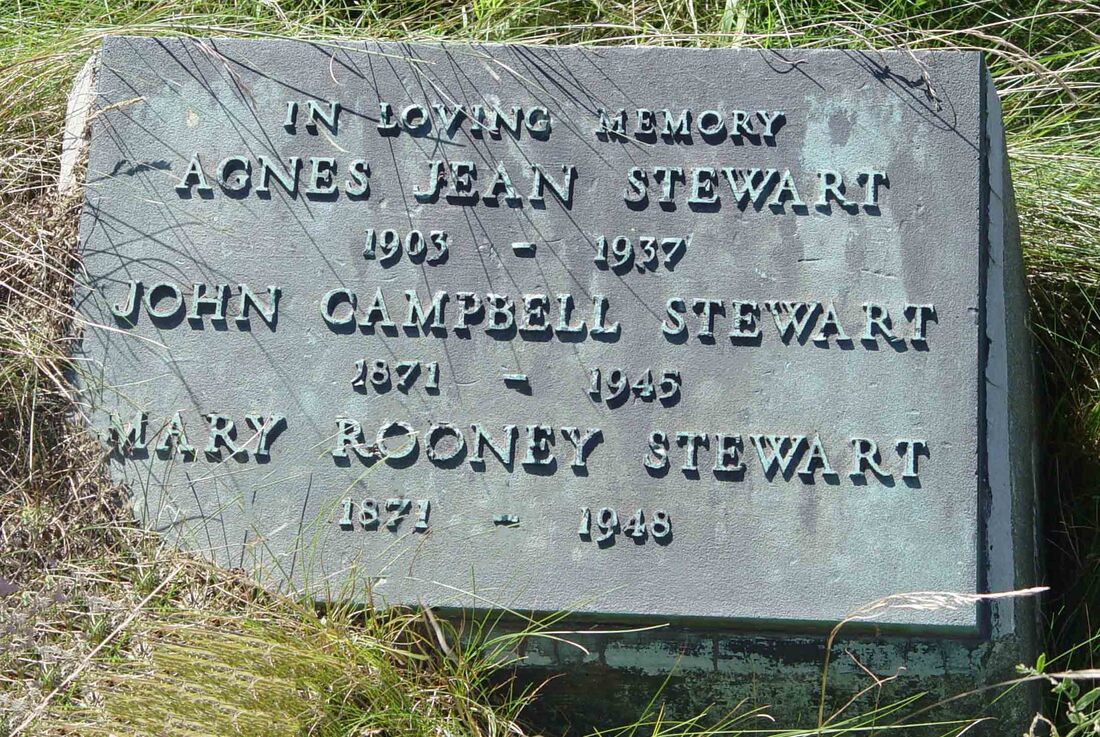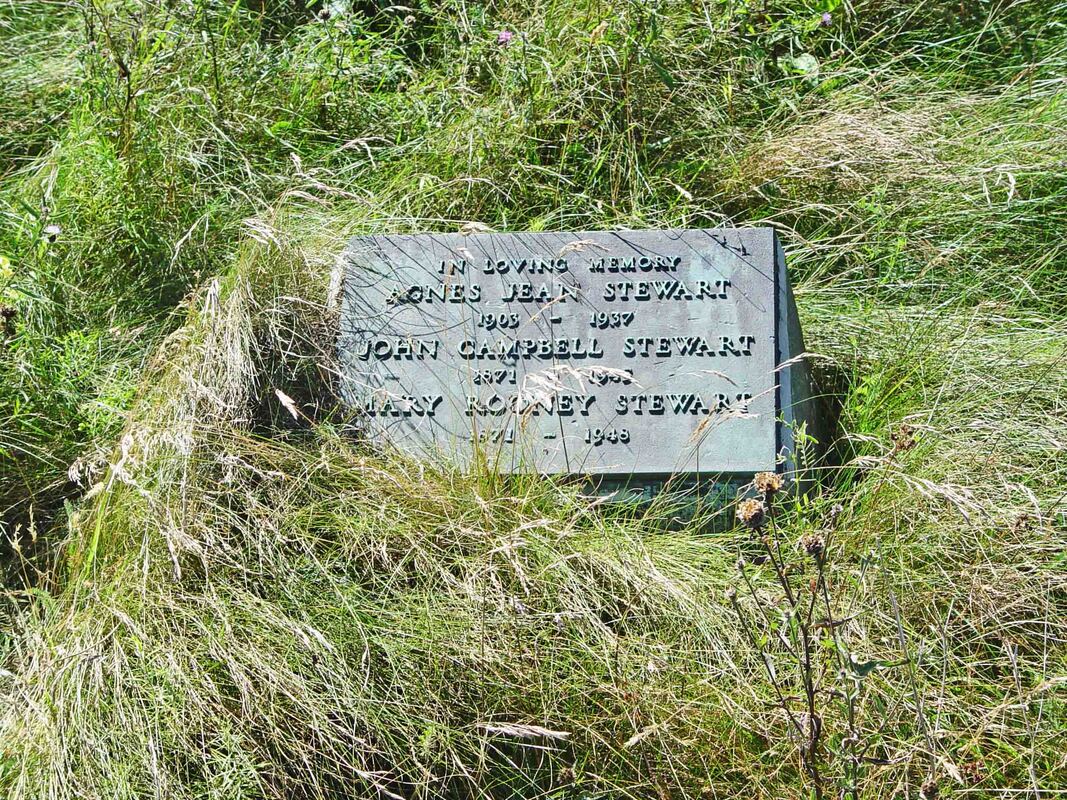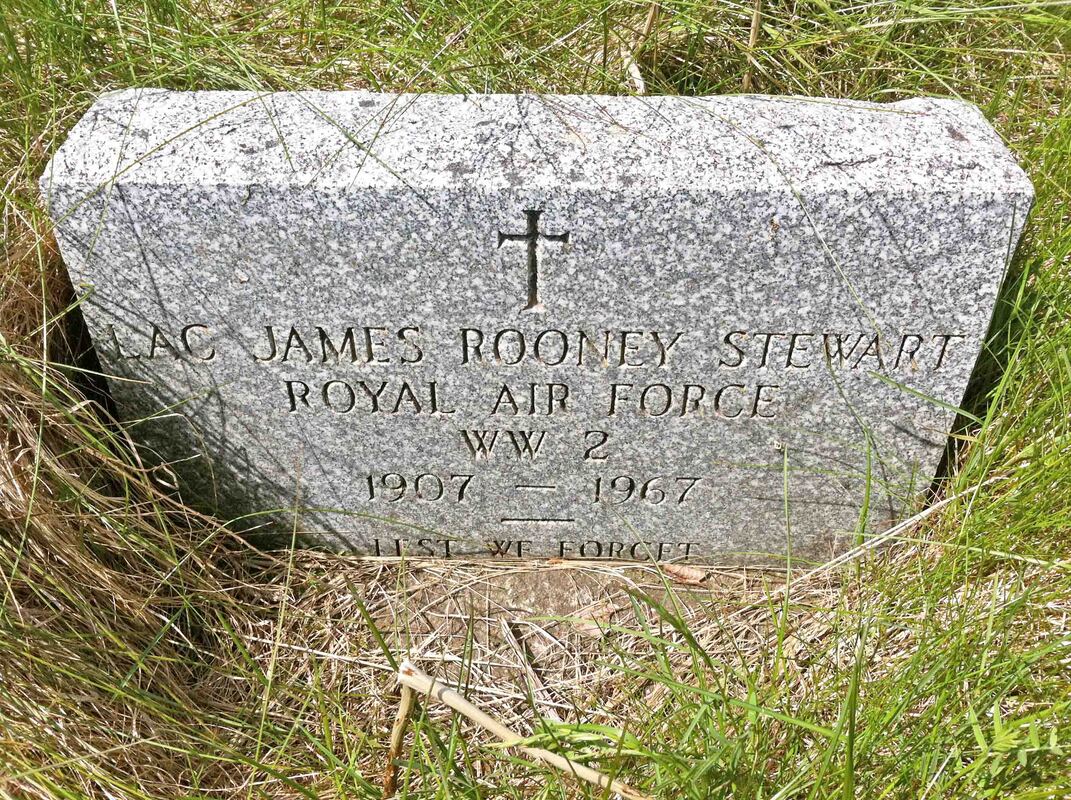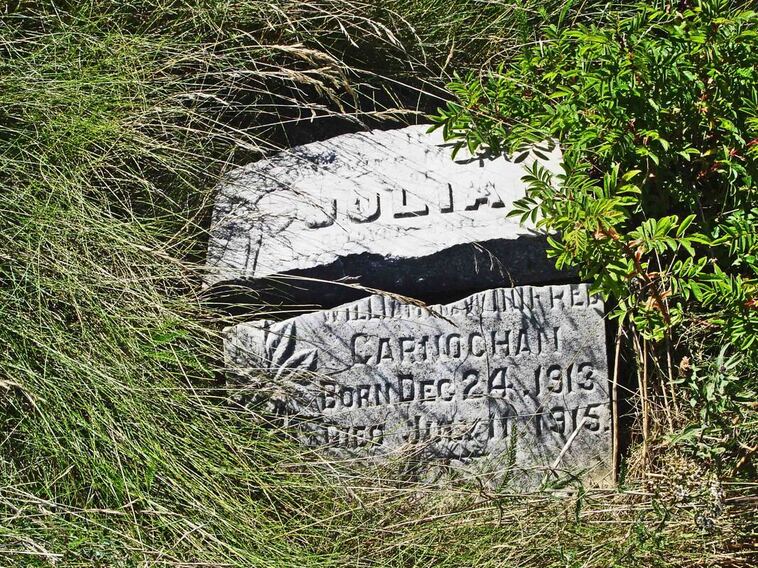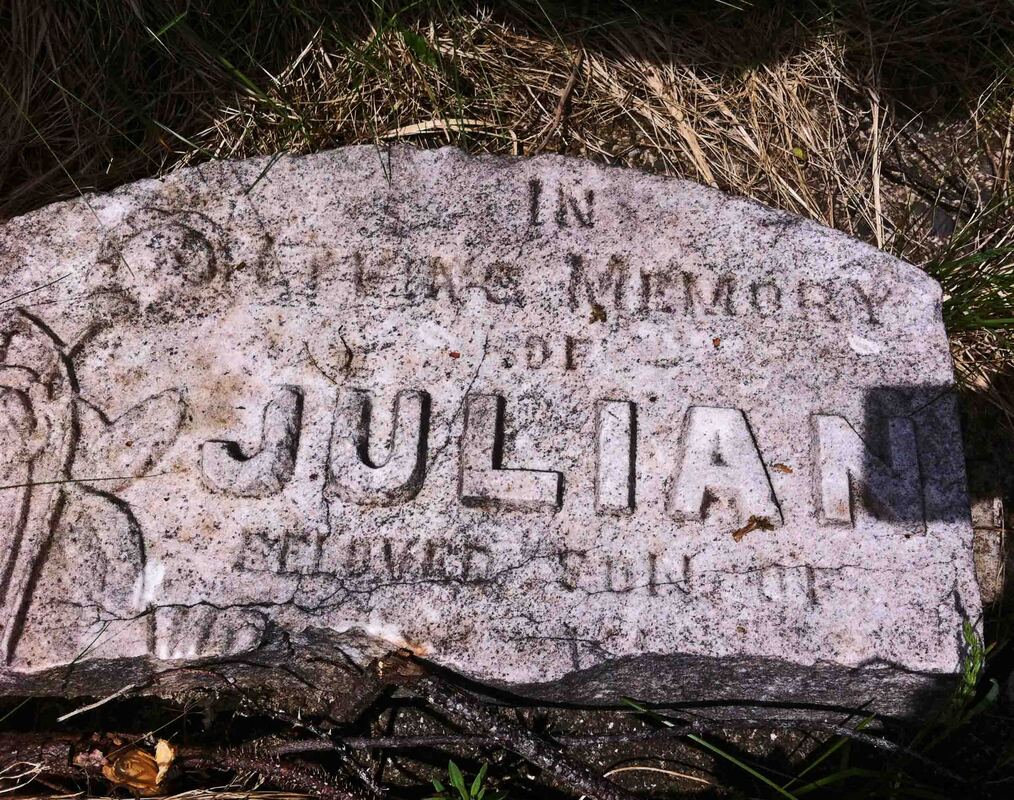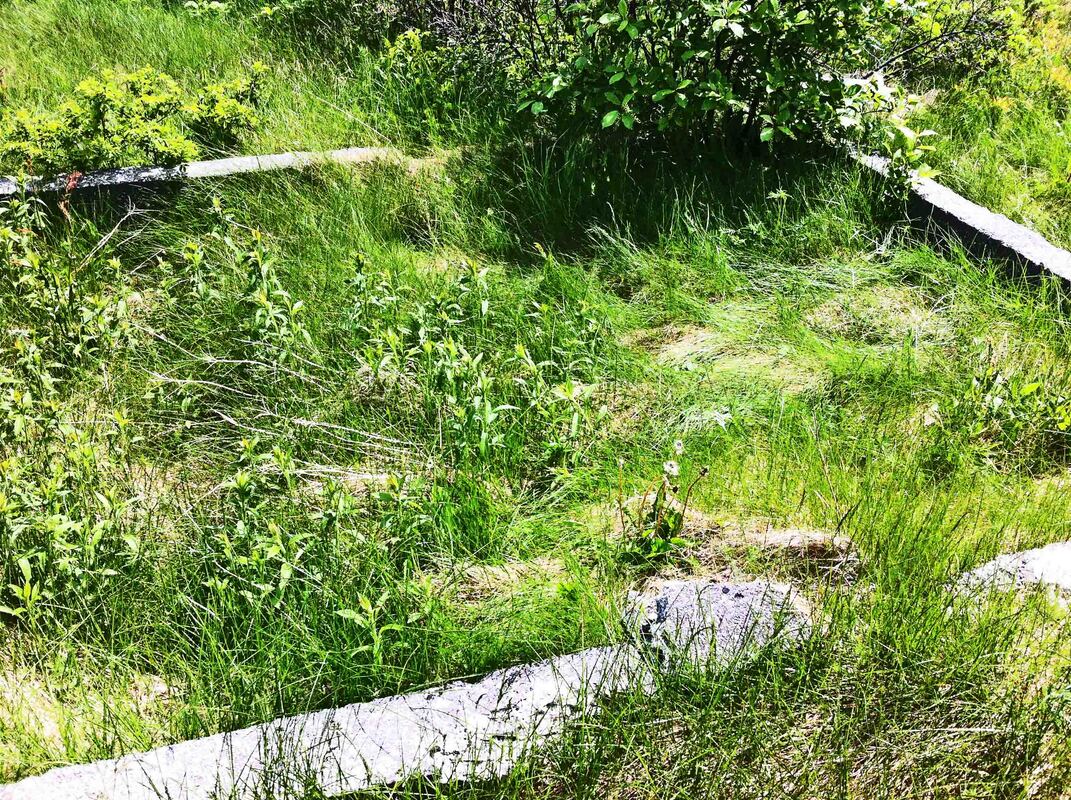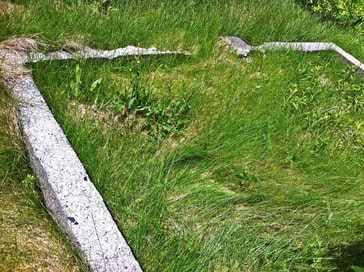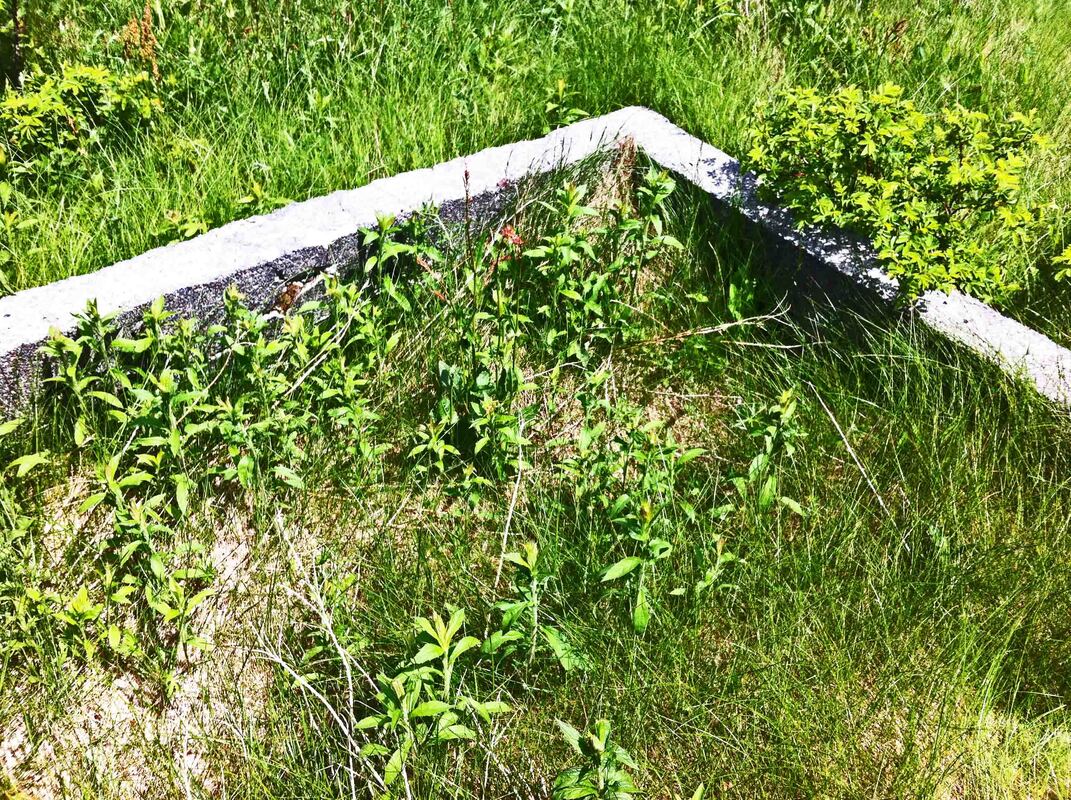HISTORY
CHURCHES
CHURCHES
PRESBYTERIAN CHURCH
1900-1917
by Gail Hussey-Weir
Created October 2021
1900-1917
by Gail Hussey-Weir
Created October 2021
No image has yet been found of the Presbyterian Church on Bell Island, but I have placed an "X" on the 1981 Census Map below showing where it was located on Kavanagh's Lane. The church building was removed in 1939, at which time the property became the Presbyterian Cemetery.
Timeline of the Presbyterian Church on Bell Island
In the Fall of 1899, the first Presbyterian service, a "one off," was held in the Roman Catholic Hall on Bell Island by Rev. James A. Greenlees, a Scotsman working with the Presbyterian Church in Canada. 39 men from Pictou County, Nova Scotia, attended this first service.
Beginning on May 7th, 1900, the Presbytery of Halifax, which had oversight of Newfoundland, appointed Rev. Greenlees to Bell Island for one year.
On August 30, 1900, the new Presbyterian church, St. Columba, seating 180, was officially opened in Kavanagh’s Lane, just a few hundred feet north of the new Methodist Church (forerunner of the United Church).
After Rev. Greenlees was transferred to Nova Scotia in September 1902, St. Columba became a mission station in the charge of a student catechist during the summer months. This situation continued, more or less, until 1918. Indeed, by 1906, attendance at St. Columba was so low the Trustees were authorized "to use the building for the best interests of the Community."
In 1918, the Home Missions Committee of Presbytery for Newfoundland decided to discontinue supplying Bell Island.
The 1919 Directory for Bell Island lists the Presbyterian Church but shows it as being "vacant" i.e. no minister.
In 1921, Reverend R.J. Power arrived in Newfoundland to serve as minister of St. Andrew's Church in St. John's and was greatly concerned that the work on Bell Island had been discontinued. He visited the Island soon after taking up his new duties to see if the Presbyterians there would like to have services once or twice a month during the summer. He reported to Sessions that he found "12 Presbyterian families and four individuals, none of whom attended any church, and who were for the most part from New Glasgow, Nova Scotia." It seems likely that the last service to be held at St. Columba's was conducted by Mr. Power.
The Almanacs for 1919-1926 list the Presbyterian Church at Wabana as "vacant."
In 1925, the United Church of Canada was founded after a merger of four Protestant denominations, two of which had churches on Bell Island. They were the Methodist Church and the Presbyterian Church. Moncrieff reports that, "Although work had been discontinued on Bell Island for a number of years before Church Union, the Commission of the Presbytery of Cape Breton and Newfoundland visited the Island in July 1927. No Report was made, and the work was not resumed there."
In the Newfoundland Census of 1935, out of a population of 6,160 permanent residents, 21 Bell Islanders listed their religious affiliation as Presbyterian.
In 1939, the St. Columba Church Hall was removed by Mr. O. Peckham, who purchased the building for $50. The Building had not been used for many years and was described as "dilapidated and out of repair." The money received, together with some assistance from the mining Company, was used to erect a fence around the Church lot, which was used as the Presbyterian Cemetery. Later the cemetery was taken over by the United Church, who promised to keep it in repair.
When the Pentecostal Chapel opened on Bell Island in 1976, that congregation approached Presbyterian Church officials for permission to take over the Presbyterian cemetery on Kavanagh's Lane and they were given approval to do that, however, as far as is known, they did not actually make use of that cemetery. When the Pentecostal Church ceased operations on Bell Island about 1994, the cemetery was left to nature.
Beginning on May 7th, 1900, the Presbytery of Halifax, which had oversight of Newfoundland, appointed Rev. Greenlees to Bell Island for one year.
On August 30, 1900, the new Presbyterian church, St. Columba, seating 180, was officially opened in Kavanagh’s Lane, just a few hundred feet north of the new Methodist Church (forerunner of the United Church).
After Rev. Greenlees was transferred to Nova Scotia in September 1902, St. Columba became a mission station in the charge of a student catechist during the summer months. This situation continued, more or less, until 1918. Indeed, by 1906, attendance at St. Columba was so low the Trustees were authorized "to use the building for the best interests of the Community."
In 1918, the Home Missions Committee of Presbytery for Newfoundland decided to discontinue supplying Bell Island.
The 1919 Directory for Bell Island lists the Presbyterian Church but shows it as being "vacant" i.e. no minister.
In 1921, Reverend R.J. Power arrived in Newfoundland to serve as minister of St. Andrew's Church in St. John's and was greatly concerned that the work on Bell Island had been discontinued. He visited the Island soon after taking up his new duties to see if the Presbyterians there would like to have services once or twice a month during the summer. He reported to Sessions that he found "12 Presbyterian families and four individuals, none of whom attended any church, and who were for the most part from New Glasgow, Nova Scotia." It seems likely that the last service to be held at St. Columba's was conducted by Mr. Power.
The Almanacs for 1919-1926 list the Presbyterian Church at Wabana as "vacant."
In 1925, the United Church of Canada was founded after a merger of four Protestant denominations, two of which had churches on Bell Island. They were the Methodist Church and the Presbyterian Church. Moncrieff reports that, "Although work had been discontinued on Bell Island for a number of years before Church Union, the Commission of the Presbytery of Cape Breton and Newfoundland visited the Island in July 1927. No Report was made, and the work was not resumed there."
In the Newfoundland Census of 1935, out of a population of 6,160 permanent residents, 21 Bell Islanders listed their religious affiliation as Presbyterian.
In 1939, the St. Columba Church Hall was removed by Mr. O. Peckham, who purchased the building for $50. The Building had not been used for many years and was described as "dilapidated and out of repair." The money received, together with some assistance from the mining Company, was used to erect a fence around the Church lot, which was used as the Presbyterian Cemetery. Later the cemetery was taken over by the United Church, who promised to keep it in repair.
When the Pentecostal Chapel opened on Bell Island in 1976, that congregation approached Presbyterian Church officials for permission to take over the Presbyterian cemetery on Kavanagh's Lane and they were given approval to do that, however, as far as is known, they did not actually make use of that cemetery. When the Pentecostal Church ceased operations on Bell Island about 1994, the cemetery was left to nature.
Before mining started on Bell Island in 1895, the only religious denominations there were Roman Catholic and Church of England (Anglican).
At first there was only one mining company on Bell Island, known locally as "The Scotia Company" or simply "Scotia." In 1899, they were joined by another company known locally as "The Dominion Company" or simply "Dominion." (For more of the history of the mining companies and their official names, go to https://www.historic-wabana.com/mining-history.html on this website.) These two companies were based in Nova Scotia. Most of their managers, mining engineers, foremen, and office workers in the early mining years on Bell Island were native Nova Scotians, who were descendants of Scots and, thus, were members of the Presbyterian Church of Scotland. It was not long after the arrival of the Dominion Company that there were enough Nova Scotians living on Bell Island to form their own Presbyterian congregation.
The first Presbyterian service was a "one off" held in the Fall of 1899 by Rev. James A. Greenlees, a Scotsman working with the Presbyterian Church in Canada. He had performed services in Harbour Grace before visiting Bell Island. As there was no Presbyterian Church Hall on Bell Island yet, this special service was held in the Roman Catholic Hall. The Presbyterian Witness reported on this service, saying it was "largely attended, including 39 men from Pictou County, Nova Scotia," and thanked "Father McGrath, the warm-hearted priest, for his kindness." Following this service, the Presbytery of Halifax, which had oversight of Newfoundland, appointed Rev. Greenlees to Bell Island for one year beginning on May 7th, 1900. The Presbytery asked the Board of Missions for a grant of $300 for the work on Bell Island, and the congregation there promised $50 per month toward his stipend.
The new church was being built that summer in Kavanagh’s Lane, just a few hundred feet north of where the new Methodist Church (forerunner of the United Church) was being built. The site was described at the time as "one of the most picturesque on Bell Island, overlooking the sea to the mainland of Newfoundland." St. Columba would seat approximately 180 people and the estimated cost of construction was between $1,000 and $1,200. A report to Presbytery stated that the following amounts were raised:
From Presbyterians on Bell Island: $270.
From the Ladies of St. Andrew's Church in St. John's: $100.
Raised by Mr. Greenlees in St. John's: $325.
Raised by Mr. Greenlees in Harbour Grace: $35.
From Mr. Moxham at head office of DISCO in Sydney, NS: $50.
From Scotia Company on Bell Island: $100.
From Dominion Company on Bell Island: $150.
St. Columba, named after the founder of the Church of Scotland, opened on August 16th, 1900. The total cost of construction was about $1,400; it opened debt-free except for $100 owing for furniture. An observer, in 1906, described it as “neat and comfortable.” (Sadly, we have not found any photos of it. If you have a photo of it, please get in touch at [email protected].) The property was held for the Church by three trustees: Messrs. R.E. Chambers, David Fraser and George Simpson (or Skinner?).
For the official opening on August 30, 1900, about 100 members of St. Andrew's congregation, including the church choir, travelled to Kelligrews by train, and from there by boat to Bell Island. The church, described as "neat, comely and creditable," was dedicated by Reverend Dr. MacRae, assisted by Reverend J.P. Falconer, Reverend W.A. Ross, Reverend J.A. Greenlees, and Reverend Henry Godfrey, who was the local Methodist minister. Hope was expressed that "this most easterly Presbyterian Church in British North America would prove a beacon light on this far-off Isle for the glory of God and the spread of His Gospel." The pulpit in the church was presented by the congregation of St. Andrew's. The Pulpit Bible was presented to the congregation by Mrs. Freebairn, wife of the Dominion Company doctor.
For the first decade, mining on Bell Island was a surface operation that would shut down late in the Fall of the year and would not resume until Spring of the following year. Once operations ceased, most of the Nova Scotians would return to their permanent homes in Nova Scotia to spend the winter months, leaving their new church virtually empty. When this happened near the end of 1900, the Presbytery of Halifax requested that the Presbytery's Home Missions Committee at St. Andrew's in St. John's "convene the brethren in Newfoundland to take into consideration the whole situation there and advise the Presbytery." It was agreed that Mr. Greenlees be asked to suspend work at Bell Island and take charge of Bay of Islands for the three or four months of the mining break. In February 1901, he expressed the hope that, "So soon as our people return to operate the mines in the spring, the Church will be reopened; and it is hoped from that time there will be no break in the work." He resumed work on Bell Island in March "with enthusiasm, holding services each morning, afternoon and evening." (Presumably the services were only on Sundays.) He wrote on April 20, 1901 that "There being no resident Methodist minister presently at the Mines, we are having what amounts to a joint service."
In the summer of 1901, Reverend D. Julius Grammer visited his son, William S. Grammer, who was the Dominion Company's resident manager on Bell Island from 1899 to 1905. Rev. Grammer was the rector of St. Thomas' Episcopal Church in Baltimore, U.S. He preached during a service at St. Columba's Church, assisted by Mr. Greenlees and the Methodist Minister, Mr. Godfrey.
Although the work looked promising throughout the spring to fall work period, Mr. Greenlees reported to the Presbytery that during winter months, the attendance and support of church services was very small and, thus, he sought instruction as to whether or not he should continue holding services in the winter of 1901-02. He was sent to Harbour Grace in December instead, with instructions to return to Wabana in May 1902 after a visit home to his native Scotland. He remained on Bell Island until September 1902, when he accepted an appointment to Sydney, N.S. The Reverend George C. Robertson served Wabana from October to December of that year. At the time, there were only six families connected to the church, the same as reported in 1901. The average Sunday attendance was twenty.
Following the resignation of Mr. Greenlees, the Presbytery's Home Missions Committee was asked "to look into the advisability of making Wabana a mission station in the charge of a student catechist during the summer months." Subsequently, James Malcolm, B.A., was appointed for the summer of 1903. Catechist M.C. McLean was appointed for the summer of 1904, but left in June "because he found so few Presbyterians there, and these were not able to give any practical support, not even to accommodate him with lodgings." Meanwhile, the Yearbook and Almanac of Newfoundland for the years 1902, 1903 and 1904 list Henry Henderson as "Elder" with the Presbyterian Church on Bell Island. Mr. Henderson had been an Elder with the Presbyterian Church at Bay of Islands for the years 1899-1901.
In 1905, the Reverend Andrew Robertson was asked to inquire concerning the present conditions on Bell Island. The matter was dealt with at the October meeting of the Presbytery, at which Mr. Greenlees was asked to be present. "He clarified the position relative to the deed of the Church property and named the Trustees. He further stated there were 30 Presbyterians on the Island. However, the Presbytery deemed it unwise to make an appointment for the summer of 1906 owing to the small number of Presbyterians now residing there... It was agreed to authorize the Trustees to use the building for the best interests of the Community."
The Yearbook and Almanac of Newfoundland for the years 1905-1914, while listing the Presbyterian ministers for other parts of Newfoundland, does not mention Bell Island at all. Moncrieff, however, reports that, after 1904, "no future appointments were made until catechist H.F. Macrae was named to work there during the summer of 1908." This came about after the Reverend R.W. Ross, Superintendent of Home Missions, visited Newfoundland in the spring of 1908 and recommended that summer supply be resumed. Dr. Andrew Robertson of St. Andrew's was appointed interim moderator for Wabana, and catechist Macrae served for that summer. During the next three summers, catechist Wilbur B. Rosborough served the congregation. Dr. John W. McMillan, clerk of the Halifax Presbytery, visited Bell Island during August 1910 and administered the Sacraments of Baptism and Holy Communion. He recommended that an Ordained Missionary be appointed to the field as soon as possible, but that was not acted upon. Catechist Thomas A. Wilson served Bell Island in the summer of 1912. In October of that year, the Reverend J.S. Sutherland of St. Andrew's visited to administer the Sacraments, at which time several new communicants were received. St. Andrew's Session agreed that "as no regular register was kept there, it was decided that the Session keep record of members residing there."
Mr. E.J.O. Fraser served as the student catechist for the summer of 1913. His stipend was paid in full by the congregation.
The St. John’s Newfoundland Directory 1913 listed him as the Presbyterian Minister for Bell Island, however, upon graduation the following year, he accepted an appointment to serve as a missionary to Korea.
The Yearbook and Almanac of Newfoundland for 1915 lists "Mr. Irving" [W.S. Irving] as being with the Presbyterian Church on Bell Island. He is not listed in the 1915 Directory for Bell Island, however. According to Moncrieff, Irving served only for a few weeks on Bell Island before being transferred to Grand Falls. By 1916, the Almanac has Mr. W.S. Irving in Grand Falls and Mr. D.A. McKenzie was serving Bell Island. W.E. Kennedy served Bell Island in the summer of 1917.
At first there was only one mining company on Bell Island, known locally as "The Scotia Company" or simply "Scotia." In 1899, they were joined by another company known locally as "The Dominion Company" or simply "Dominion." (For more of the history of the mining companies and their official names, go to https://www.historic-wabana.com/mining-history.html on this website.) These two companies were based in Nova Scotia. Most of their managers, mining engineers, foremen, and office workers in the early mining years on Bell Island were native Nova Scotians, who were descendants of Scots and, thus, were members of the Presbyterian Church of Scotland. It was not long after the arrival of the Dominion Company that there were enough Nova Scotians living on Bell Island to form their own Presbyterian congregation.
The first Presbyterian service was a "one off" held in the Fall of 1899 by Rev. James A. Greenlees, a Scotsman working with the Presbyterian Church in Canada. He had performed services in Harbour Grace before visiting Bell Island. As there was no Presbyterian Church Hall on Bell Island yet, this special service was held in the Roman Catholic Hall. The Presbyterian Witness reported on this service, saying it was "largely attended, including 39 men from Pictou County, Nova Scotia," and thanked "Father McGrath, the warm-hearted priest, for his kindness." Following this service, the Presbytery of Halifax, which had oversight of Newfoundland, appointed Rev. Greenlees to Bell Island for one year beginning on May 7th, 1900. The Presbytery asked the Board of Missions for a grant of $300 for the work on Bell Island, and the congregation there promised $50 per month toward his stipend.
The new church was being built that summer in Kavanagh’s Lane, just a few hundred feet north of where the new Methodist Church (forerunner of the United Church) was being built. The site was described at the time as "one of the most picturesque on Bell Island, overlooking the sea to the mainland of Newfoundland." St. Columba would seat approximately 180 people and the estimated cost of construction was between $1,000 and $1,200. A report to Presbytery stated that the following amounts were raised:
From Presbyterians on Bell Island: $270.
From the Ladies of St. Andrew's Church in St. John's: $100.
Raised by Mr. Greenlees in St. John's: $325.
Raised by Mr. Greenlees in Harbour Grace: $35.
From Mr. Moxham at head office of DISCO in Sydney, NS: $50.
From Scotia Company on Bell Island: $100.
From Dominion Company on Bell Island: $150.
St. Columba, named after the founder of the Church of Scotland, opened on August 16th, 1900. The total cost of construction was about $1,400; it opened debt-free except for $100 owing for furniture. An observer, in 1906, described it as “neat and comfortable.” (Sadly, we have not found any photos of it. If you have a photo of it, please get in touch at [email protected].) The property was held for the Church by three trustees: Messrs. R.E. Chambers, David Fraser and George Simpson (or Skinner?).
For the official opening on August 30, 1900, about 100 members of St. Andrew's congregation, including the church choir, travelled to Kelligrews by train, and from there by boat to Bell Island. The church, described as "neat, comely and creditable," was dedicated by Reverend Dr. MacRae, assisted by Reverend J.P. Falconer, Reverend W.A. Ross, Reverend J.A. Greenlees, and Reverend Henry Godfrey, who was the local Methodist minister. Hope was expressed that "this most easterly Presbyterian Church in British North America would prove a beacon light on this far-off Isle for the glory of God and the spread of His Gospel." The pulpit in the church was presented by the congregation of St. Andrew's. The Pulpit Bible was presented to the congregation by Mrs. Freebairn, wife of the Dominion Company doctor.
For the first decade, mining on Bell Island was a surface operation that would shut down late in the Fall of the year and would not resume until Spring of the following year. Once operations ceased, most of the Nova Scotians would return to their permanent homes in Nova Scotia to spend the winter months, leaving their new church virtually empty. When this happened near the end of 1900, the Presbytery of Halifax requested that the Presbytery's Home Missions Committee at St. Andrew's in St. John's "convene the brethren in Newfoundland to take into consideration the whole situation there and advise the Presbytery." It was agreed that Mr. Greenlees be asked to suspend work at Bell Island and take charge of Bay of Islands for the three or four months of the mining break. In February 1901, he expressed the hope that, "So soon as our people return to operate the mines in the spring, the Church will be reopened; and it is hoped from that time there will be no break in the work." He resumed work on Bell Island in March "with enthusiasm, holding services each morning, afternoon and evening." (Presumably the services were only on Sundays.) He wrote on April 20, 1901 that "There being no resident Methodist minister presently at the Mines, we are having what amounts to a joint service."
In the summer of 1901, Reverend D. Julius Grammer visited his son, William S. Grammer, who was the Dominion Company's resident manager on Bell Island from 1899 to 1905. Rev. Grammer was the rector of St. Thomas' Episcopal Church in Baltimore, U.S. He preached during a service at St. Columba's Church, assisted by Mr. Greenlees and the Methodist Minister, Mr. Godfrey.
Although the work looked promising throughout the spring to fall work period, Mr. Greenlees reported to the Presbytery that during winter months, the attendance and support of church services was very small and, thus, he sought instruction as to whether or not he should continue holding services in the winter of 1901-02. He was sent to Harbour Grace in December instead, with instructions to return to Wabana in May 1902 after a visit home to his native Scotland. He remained on Bell Island until September 1902, when he accepted an appointment to Sydney, N.S. The Reverend George C. Robertson served Wabana from October to December of that year. At the time, there were only six families connected to the church, the same as reported in 1901. The average Sunday attendance was twenty.
Following the resignation of Mr. Greenlees, the Presbytery's Home Missions Committee was asked "to look into the advisability of making Wabana a mission station in the charge of a student catechist during the summer months." Subsequently, James Malcolm, B.A., was appointed for the summer of 1903. Catechist M.C. McLean was appointed for the summer of 1904, but left in June "because he found so few Presbyterians there, and these were not able to give any practical support, not even to accommodate him with lodgings." Meanwhile, the Yearbook and Almanac of Newfoundland for the years 1902, 1903 and 1904 list Henry Henderson as "Elder" with the Presbyterian Church on Bell Island. Mr. Henderson had been an Elder with the Presbyterian Church at Bay of Islands for the years 1899-1901.
In 1905, the Reverend Andrew Robertson was asked to inquire concerning the present conditions on Bell Island. The matter was dealt with at the October meeting of the Presbytery, at which Mr. Greenlees was asked to be present. "He clarified the position relative to the deed of the Church property and named the Trustees. He further stated there were 30 Presbyterians on the Island. However, the Presbytery deemed it unwise to make an appointment for the summer of 1906 owing to the small number of Presbyterians now residing there... It was agreed to authorize the Trustees to use the building for the best interests of the Community."
The Yearbook and Almanac of Newfoundland for the years 1905-1914, while listing the Presbyterian ministers for other parts of Newfoundland, does not mention Bell Island at all. Moncrieff, however, reports that, after 1904, "no future appointments were made until catechist H.F. Macrae was named to work there during the summer of 1908." This came about after the Reverend R.W. Ross, Superintendent of Home Missions, visited Newfoundland in the spring of 1908 and recommended that summer supply be resumed. Dr. Andrew Robertson of St. Andrew's was appointed interim moderator for Wabana, and catechist Macrae served for that summer. During the next three summers, catechist Wilbur B. Rosborough served the congregation. Dr. John W. McMillan, clerk of the Halifax Presbytery, visited Bell Island during August 1910 and administered the Sacraments of Baptism and Holy Communion. He recommended that an Ordained Missionary be appointed to the field as soon as possible, but that was not acted upon. Catechist Thomas A. Wilson served Bell Island in the summer of 1912. In October of that year, the Reverend J.S. Sutherland of St. Andrew's visited to administer the Sacraments, at which time several new communicants were received. St. Andrew's Session agreed that "as no regular register was kept there, it was decided that the Session keep record of members residing there."
Mr. E.J.O. Fraser served as the student catechist for the summer of 1913. His stipend was paid in full by the congregation.
The St. John’s Newfoundland Directory 1913 listed him as the Presbyterian Minister for Bell Island, however, upon graduation the following year, he accepted an appointment to serve as a missionary to Korea.
The Yearbook and Almanac of Newfoundland for 1915 lists "Mr. Irving" [W.S. Irving] as being with the Presbyterian Church on Bell Island. He is not listed in the 1915 Directory for Bell Island, however. According to Moncrieff, Irving served only for a few weeks on Bell Island before being transferred to Grand Falls. By 1916, the Almanac has Mr. W.S. Irving in Grand Falls and Mr. D.A. McKenzie was serving Bell Island. W.E. Kennedy served Bell Island in the summer of 1917.
Rev. Moncrieff's list of Ministers of St. Columba's Church:
The Reverend Joseph A. Greenlees, M.A. (O.M.), May 1900 to Sept. 1902
The Reverend George C. Robertson, Oct. to Dec. 1902
James Malcolm (student catechist), summer 1903
M. C. McLean (student catechist), summer 1904
H.F. Macrae (student catechist), summer 1908
Wilbur E. Rosborough (student catechist), summer 1909, summer 1910, summer 1911
Thomas A. Wilson (student catechist), summer 1912
E.J.O. Fraser, (catechist), summer 1913
W.S. Irving, summer 1914
D.A. McKenzie, summer 1915
W.E. Kennedy, summer 1917.
The Reverend Joseph A. Greenlees, M.A. (O.M.), May 1900 to Sept. 1902
The Reverend George C. Robertson, Oct. to Dec. 1902
James Malcolm (student catechist), summer 1903
M. C. McLean (student catechist), summer 1904
H.F. Macrae (student catechist), summer 1908
Wilbur E. Rosborough (student catechist), summer 1909, summer 1910, summer 1911
Thomas A. Wilson (student catechist), summer 1912
E.J.O. Fraser, (catechist), summer 1913
W.S. Irving, summer 1914
D.A. McKenzie, summer 1915
W.E. Kennedy, summer 1917.
The Presbyterian Church seemed to be having problems supplying ministers to serve Newfoundland in general at this time and, according to the Almanac for 1917, Wabana, Bay of Islands and Grand Falls all had vacancies. Indeed, according to the entry for "Presbyterian Church" in the Encyclopedia of Newfoundland and Labrador, V. 4, pp. 443-44, the Halifax Presbytery was encouraging "cooperation with Methodist Churches." That article goes on to state that the mission of St. Columba on Bell Island was started in 1899 and lasted only until 1917.
According to the Almanac for 1918, the Rev. S.H. Thompson, D. Sc. was serving Bell Island, but this must also have been short-lived as the Home Missions Committee of Presbytery for Newfoundland decided that year to discontinue supplying Bell Island. The 1919 Directory for Bell Island lists the Presbyterian Church but shows it as being "vacant" i.e. no minister.
Reverend R.J. Power arrived in Newfoundland to serve as minister of St. Andrew's Church in St. John's in 1921 and was greatly concerned that the work on Bell Island had been discontinued. He visited the Island soon after taking up his new duties to see if the Presbyterians there would like to have services once or twice a month during the summer. He reported to Sessions that he found "12 Presbyterian families and four individuals, none of whom attended any church, and who were for the most part from New Glasgow, Nova Scotia." It seems likely that the last service to be held at St. Columba's was conducted by Mr. Power. It is believed that prior to that some services had been conducted by the Reverend F.S. Coffin, who was minister at Harbour Grace for a number of years.
The Almanacs for 1919-1926 list the Presbyterian Church at Wabana as "vacant."
In 1925, the United Church of Canada was founded after a merger of four Protestant denominations, two of which had churches on Bell Island. They were the Methodist Church and the Presbyterian Church. (In actual fact, only two-thirds of Canada's Presbyterian Churches merged into the United Church, but the one on Bell Island did.) Moncrieff reports that, "Although work had been discontinued on Bell Island for a number of years before Church Union, the Commission of the Presbytery of Cape Breton and Newfoundland visited the Island in July 1927. No Report was made, and the work was not resumed there."
From Moncreiff we learn that:
In 1939, the St. Columba Church Hall was removed by Mr. O. Peckham, who purchased the building for $50. The Building had not been used for many years and was described as "dilapidated and out of repair." Before the building was sold, contact had been made with the United Church minister there, the Reverend M.S. Bennett, to inquire if the building would be of any use to him for religious or social purposes. He replied that the Church was "useless" and that $50 was a generous offer! Mr. R.A. Templeton, clerk of St. Andrew's Session, was in correspondence with Mr. J.C. Stewart and Mr. C. Archibald. The latter agreeing to the sale, the offer was accepted. The money received, together with some assistance from the Company, was used to erect a fence around the Church lot, which was used as the Presbyterian Cemetery. Later the cemetery was taken over by the United Church, who promised to keep it in repair.
For many years, the property was kept in repair by Mr. J.C. Stewart at his own expense. This devout and faithful Presbyterian came to Bell Island from Little Bay [or Little Bay Islands?] and set up a business in the early days of mining. Although many baptisms took place on the Island, only one is said to have been administered in the Church. This was the baptism of George Arneil, son of Mr. Stewart, performed by Mr. Greenlees. His [Stewart's] son, James, was buried in the Presbyterian Cemetery in the summer of 1967. [Read John C. Stewart's bio on this website at https://www.historic-wabana.com/s.html.]
Among the Presbyterians who lived on Bell Island for some time was Dr. W.L.C. Carnochan. [Read his bio on this website at https://www.historic-wabana.com/c.html.] He came to Newfoundland from Ontario about 1904 and practiced in Petries, then Harbour Grace before moving to Bell Island about 1906-07. There, he was the physician for the Scotia Company until 1922, when the family moved to the United States. His son, Julian, who died in infancy, is buried in the Presbyterian Cemetery.
In 2016, I contacted volunteers in charge of the archives of the two Presbyterian Churches in St. John's in the hope they would have early records of the St. Columba Presbyterian Church on Bell Island. I was told that they did not have any information on it. I then searched the United Church Archives at the U.C. Conference Office in St. John's. I did not find any references to St. Columba there either, but I did find some mention of Presbyterian members of the Bell Island United Church in what looks like a 1933 "List of United Church Families." Next to most of the names on the list, the new minister had made notes to help him locate the parishioners' homes. In those days, most streets did not have names, let alone street signs and there were no street numbers on the houses. Thus, parishioner No. 3 was "William Lindsay, Presbyterian, Back of Arena." Parishioner No. 69 was "J.C. Stewart, Presbyterian, Lance Cove Road." (J.C. Stewart was the Chair of the Board of Stewards in 1932-33.) Parishioner No. 131 was "Reginald Taylor, this is a Presbyterian family, but attends our church occasionally."
In the Newfoundland Census of 1935, out of a population of 6,160 permanent residents, 21 Bell Islanders listed their religious affiliation as Presbyterian.
According to the Almanac for 1918, the Rev. S.H. Thompson, D. Sc. was serving Bell Island, but this must also have been short-lived as the Home Missions Committee of Presbytery for Newfoundland decided that year to discontinue supplying Bell Island. The 1919 Directory for Bell Island lists the Presbyterian Church but shows it as being "vacant" i.e. no minister.
Reverend R.J. Power arrived in Newfoundland to serve as minister of St. Andrew's Church in St. John's in 1921 and was greatly concerned that the work on Bell Island had been discontinued. He visited the Island soon after taking up his new duties to see if the Presbyterians there would like to have services once or twice a month during the summer. He reported to Sessions that he found "12 Presbyterian families and four individuals, none of whom attended any church, and who were for the most part from New Glasgow, Nova Scotia." It seems likely that the last service to be held at St. Columba's was conducted by Mr. Power. It is believed that prior to that some services had been conducted by the Reverend F.S. Coffin, who was minister at Harbour Grace for a number of years.
The Almanacs for 1919-1926 list the Presbyterian Church at Wabana as "vacant."
In 1925, the United Church of Canada was founded after a merger of four Protestant denominations, two of which had churches on Bell Island. They were the Methodist Church and the Presbyterian Church. (In actual fact, only two-thirds of Canada's Presbyterian Churches merged into the United Church, but the one on Bell Island did.) Moncrieff reports that, "Although work had been discontinued on Bell Island for a number of years before Church Union, the Commission of the Presbytery of Cape Breton and Newfoundland visited the Island in July 1927. No Report was made, and the work was not resumed there."
From Moncreiff we learn that:
In 1939, the St. Columba Church Hall was removed by Mr. O. Peckham, who purchased the building for $50. The Building had not been used for many years and was described as "dilapidated and out of repair." Before the building was sold, contact had been made with the United Church minister there, the Reverend M.S. Bennett, to inquire if the building would be of any use to him for religious or social purposes. He replied that the Church was "useless" and that $50 was a generous offer! Mr. R.A. Templeton, clerk of St. Andrew's Session, was in correspondence with Mr. J.C. Stewart and Mr. C. Archibald. The latter agreeing to the sale, the offer was accepted. The money received, together with some assistance from the Company, was used to erect a fence around the Church lot, which was used as the Presbyterian Cemetery. Later the cemetery was taken over by the United Church, who promised to keep it in repair.
For many years, the property was kept in repair by Mr. J.C. Stewart at his own expense. This devout and faithful Presbyterian came to Bell Island from Little Bay [or Little Bay Islands?] and set up a business in the early days of mining. Although many baptisms took place on the Island, only one is said to have been administered in the Church. This was the baptism of George Arneil, son of Mr. Stewart, performed by Mr. Greenlees. His [Stewart's] son, James, was buried in the Presbyterian Cemetery in the summer of 1967. [Read John C. Stewart's bio on this website at https://www.historic-wabana.com/s.html.]
Among the Presbyterians who lived on Bell Island for some time was Dr. W.L.C. Carnochan. [Read his bio on this website at https://www.historic-wabana.com/c.html.] He came to Newfoundland from Ontario about 1904 and practiced in Petries, then Harbour Grace before moving to Bell Island about 1906-07. There, he was the physician for the Scotia Company until 1922, when the family moved to the United States. His son, Julian, who died in infancy, is buried in the Presbyterian Cemetery.
In 2016, I contacted volunteers in charge of the archives of the two Presbyterian Churches in St. John's in the hope they would have early records of the St. Columba Presbyterian Church on Bell Island. I was told that they did not have any information on it. I then searched the United Church Archives at the U.C. Conference Office in St. John's. I did not find any references to St. Columba there either, but I did find some mention of Presbyterian members of the Bell Island United Church in what looks like a 1933 "List of United Church Families." Next to most of the names on the list, the new minister had made notes to help him locate the parishioners' homes. In those days, most streets did not have names, let alone street signs and there were no street numbers on the houses. Thus, parishioner No. 3 was "William Lindsay, Presbyterian, Back of Arena." Parishioner No. 69 was "J.C. Stewart, Presbyterian, Lance Cove Road." (J.C. Stewart was the Chair of the Board of Stewards in 1932-33.) Parishioner No. 131 was "Reginald Taylor, this is a Presbyterian family, but attends our church occasionally."
In the Newfoundland Census of 1935, out of a population of 6,160 permanent residents, 21 Bell Islanders listed their religious affiliation as Presbyterian.
The Presbyterian Cemetery on Bell Island
From the history above, gathered by Rev. Moncrieff, we know that St. Columba Church Hall was removed from the Presbyterian Church property in 1939. The money received, together with some assistance from the Company, was used to erect a fence around the Church lot, which was used as the Presbyterian Cemetery. Later the cemetery was taken over by the United Church, who promised to keep it in repair. For many years, the property was kept in repair by Mr. J.C. Stewart at his own expense. . . His son, James, was buried in the Presbyterian Cemetery in the summer of 1967. . . Among the Presbyterians who lived on Bell Island for some time was Dr. W.L.C. Carnochan. . . His son, Julian, who died in infancy, is buried in the Presbyterian Cemetery.
I first became aware of the Presbyterian Cemetery in 2010 while chatting with members of the Board of Jackson United Church one day prior to the annual Flower Service at the United Church Cemetery. Their understanding was that the Pentecostal Church that opened on Bell Island in 1976 approached Presbyterian Church officials for permission to take over the Presbyterian cemetery on Kavanagh's Lane and they were given approval to do that, however, as far as is known, they did not actually make use of that cemetery. When the Pentecostal Church ceased operations on Bell Island about 1994, the cemetery was left to nature. According to a history of the Bell Island Pentecostal Church posted on the "Newfoundland's Grand Banks" website, some Pentecostal members are buried "at the front of the RC Cemetery at the Front of the Island."
The Presbyterian Cemetery is at the southwest end of Kavanagh's Lane, where it meets Wood's Avenue. I have placed an "X" to mark the spot on the map below. I first visited it in September of 2010. Because it is in the point where these two roads meet, it was not a problem to locate, but there was no signage to indicate that it was a cemetery. From the road, a few fence posts on its eastern edge could be seen, but no fence. To get into the cemetery, it was necessary to traverse a ditch, so just getting onto the property is not for the faint of heart. The property was quite overgrown with grass, weeds, shrubs and wild roses, and the ground was so uneven that it was difficult to walk on without fear of twisting an ankle. During this brief visit, my husband and I found only two headstones, the one shown below for Agnes, John and Mary Stewart, and the broken one for Julian Carnochan.
I first became aware of the Presbyterian Cemetery in 2010 while chatting with members of the Board of Jackson United Church one day prior to the annual Flower Service at the United Church Cemetery. Their understanding was that the Pentecostal Church that opened on Bell Island in 1976 approached Presbyterian Church officials for permission to take over the Presbyterian cemetery on Kavanagh's Lane and they were given approval to do that, however, as far as is known, they did not actually make use of that cemetery. When the Pentecostal Church ceased operations on Bell Island about 1994, the cemetery was left to nature. According to a history of the Bell Island Pentecostal Church posted on the "Newfoundland's Grand Banks" website, some Pentecostal members are buried "at the front of the RC Cemetery at the Front of the Island."
The Presbyterian Cemetery is at the southwest end of Kavanagh's Lane, where it meets Wood's Avenue. I have placed an "X" to mark the spot on the map below. I first visited it in September of 2010. Because it is in the point where these two roads meet, it was not a problem to locate, but there was no signage to indicate that it was a cemetery. From the road, a few fence posts on its eastern edge could be seen, but no fence. To get into the cemetery, it was necessary to traverse a ditch, so just getting onto the property is not for the faint of heart. The property was quite overgrown with grass, weeds, shrubs and wild roses, and the ground was so uneven that it was difficult to walk on without fear of twisting an ankle. During this brief visit, my husband and I found only two headstones, the one shown below for Agnes, John and Mary Stewart, and the broken one for Julian Carnochan.
It was 10 years later, in June 2020, that we paid a second visit to the Presbyterian Cemetery. It was still terribly overgrown with grass and wild roses, and there was actually a wild rose bush growing up through the cracked headstone of Baby Julian Carnochan. This time we wore more appropriate footwear and were determined to make more effort to search for signs of graves. As a result, we found the headstone of James Stewart and the nearby concrete surround of what is possibly two graves, although we could not locate any other headstones. There are possibly more, but the grass and shrubs were too thick and the terrain was too rough to see anything else.
Headstones in the Presbyterian Cemetery
John Campbell Stewart (1871-1945) was a businessman on Bell Island for about 45 years, starting around 1900. He and his wife, Mary Rooney Stewart (1871-1948), were both born in Scotland. Agnes Jean (1903-1937) was their daughter. You can view his bio at https://www.historic-wabana.com/s.html.
Headstone of LAC [Leading Aircraftman] James Rooney Stewart, 1907-1967, who served in the Royal Air Force in WW2. He was the son of James C. and Mary Stewart.
Julian Carnochan (1913-1915) was the son of Winifred and Dr. William Carnochan, who was the physician for the Scotia Company on Bell Island from 1906-1922. Read his bio on this website at https://www.historic-wabana.com/c.html. Julian's headstone reads, "In Loving Memory of Julian, Beloved Son of William and Winifred Carnochan, Born Dec. 24, 1913, Died July 11, 1915."
The photo below shows the cement surround of a double plot in the Presbyterian Cemetery, but no headstone was found for it. (The headstone may be on the ground and hidden by the overgrown grass and shrubs.) George Stewart (1883-1923) was the brother of John Campbell Stewart. George died in 1923 at age 40 of pulmonary tuberculosis. No doubt he is buried in this cemetery and perhaps in this plot. George and his wife, Bertha, had two children, Elizabeth and George, who died in 1918 and 1923 respectively, who are probably buried in this cemetery as well.
Quite aside from the history of the Presbyterian Church and the headstones that remain in the former church property, now the Presbyterian Cemetery, the following tragic story was recorded in the Daily News in October 1925; no other information was given:
The Island was shocked by a tragedy on the night of October 23 [1925] when James, 13-year-old son of William Jackman, mailman, fell into a cesspool in the Presbyterian yard during a severe storm and was drowned.
Source: Addison Bown, "Newspaper History of Bell Island," 1925, p. 12.
The Island was shocked by a tragedy on the night of October 23 [1925] when James, 13-year-old son of William Jackman, mailman, fell into a cesspool in the Presbyterian yard during a severe storm and was drowned.
Source: Addison Bown, "Newspaper History of Bell Island," 1925, p. 12.
